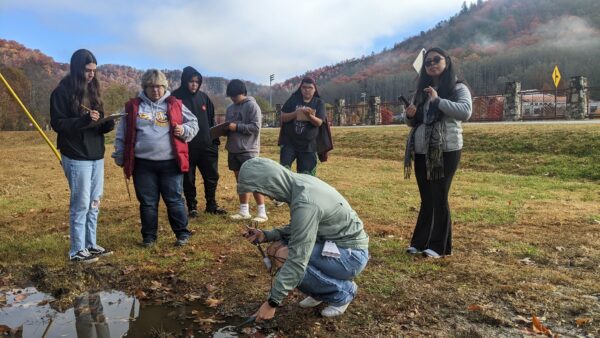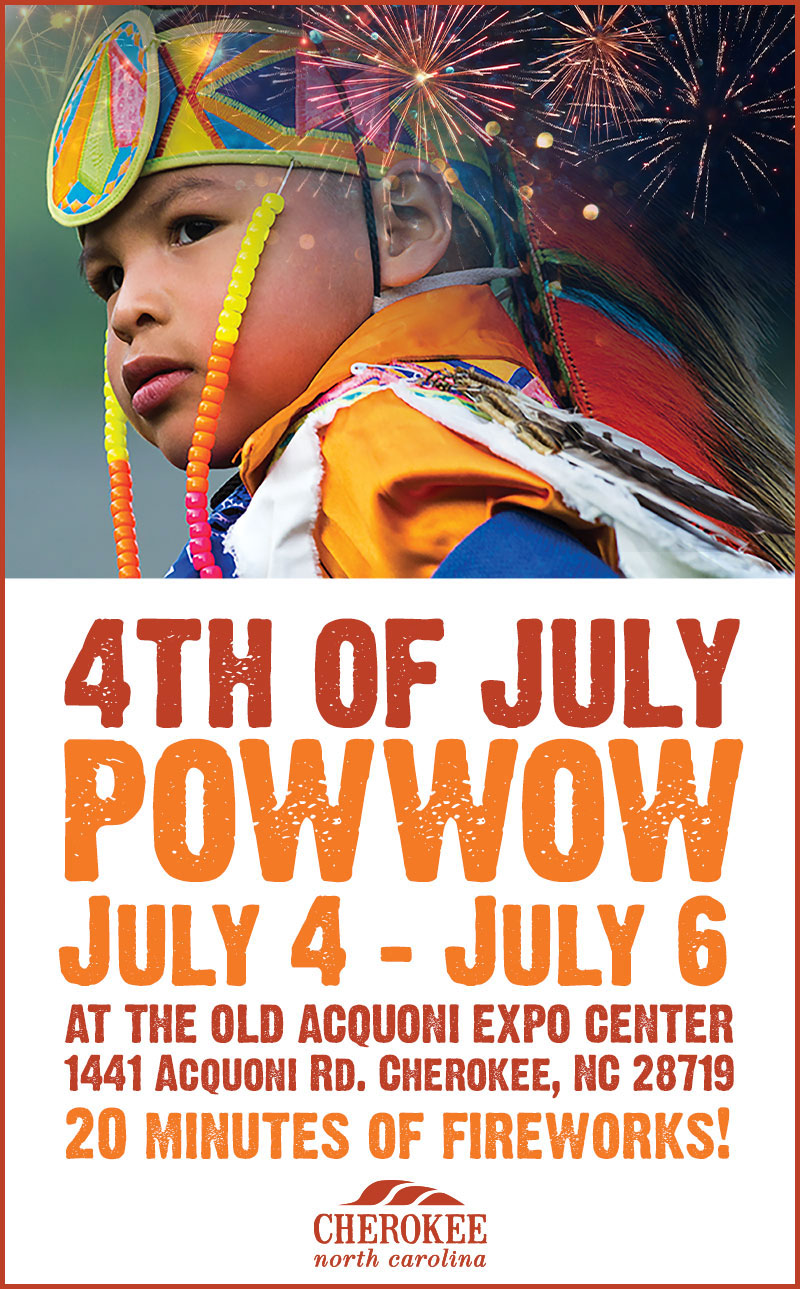By JONAH LOSSIAH
One Feather Reporter
CHEROKEE, N.C. – January 2020 was a much different time. While the next few months would completely shift the landscape of everything in life, Sara Duncan’s focus on a new program at Cherokee Central Schools (CCS) did not falter.
For Duncan, an assistant professor at Western Carolina University (WCU), air quality is a passion – the study of it, teaching it, and understanding how we as humans impact our environment. She wanted to bring this topic to CCS. Despite the endless hoops of pandemic safety and trial and error, Duncan has now been working on this project for three years and has facilitated two programs through the school.

CHS Teacher Ronda Denton, second from left back, watches her students collect water samples from a puddle outside of Cherokee Central Schools recently. Shown, left to right, back row – Sara O’Kelley, CHS student; Denton; Da-Wo-Ni Dv-do-s-di, CHS student; Oscar Swayney, CHS student, Ayden Queen, CHS student, and Dominique Picazo Feliciauo, WCU student; and Guadalupe Castillo-Esparza, WCU student, is shown testing the water. (Photo contributed)
“It started off really fast, I’m a big dreamer. Then, the pandemic and just kind of figuring out how to navigate everything. It slowed down, but now we’re at this place where we have these relationships. Now, hopefully we can build something and answer questions. Right now, students are able to do a science project and they’re excited about it. They see the relationship with their own communities and what they’re learned historically from being Cherokee and also the applications that they can have in the future. Potentially solving problems that matter here in Cherokee,” said Duncan.
Initially, Duncan was focused on air quality reading, but now the program also incorporates water quality lessons. The most recent outing in Cherokee saw Duncan and her associates from WCU work with about 40 students at CCS.
“The Science Education program at Western (WCU), there are a few students that come in and do some water and air quality lessons with the kids. Then they take their measurements around school. What is the water quality like coming out of the bubbler or something. Or what is the air quality like in the cafeteria? So, they can see what their personal exposure is like.”
Duncan said that she and her team from WCU want to raise awareness of how air and water quality impact a community, culture, and history. This program has them working with the air and water quality devices, studying what impacts those numbers, and they have also spent time interviewing elders on the Qualla Boundary to get a sense of the community history surrounding air and water quality.
“The ultimate goal for them is to see how who they are culturally from their community doesn’t have to do be divorced from what they’re learning about in these scientific practices that we use in the modern world,” said Duncan.
Duncan has worked with several stakeholders in Cherokee to make this collaboration happen. The initial efforts have been funded by the Cherokee Preservation Foundation. She has received air quality kits from Katie Tiger, EBCI Air Quality Program supervisor. Duncan has also stayed in consistent contact with Ronda Denton, the Cherokee High School teacher who has hosted the program.
“The kids have enjoyed it,” said Denton. “I think it’s bringing a lot out in terms of them trying to look at their culture. How air quality and water quality have changed. Especially when we talk to the elders and the kids do the interviews with the elders.”.
Along with getting kits to bring to the school, the program also allowed students to visit the larger, more accurate air quality monitors that the Tribe operates. This is another piece that Tiger helped with.
“Our role was just being the Tribal point of contact and letting the kids come out to our air monitoring station and let them see the big instruments that we use. They’re called federal reference methods. They’re the EPA standard for monitoring ambient air,” said Tiger.
Denton said that getting to be hands-on with materials was one of the most valuable pieces of the program, but that she hopes to make that concept more of a focus in future programs.
“I wish we had more time to do that. During a class period, to me, is not enough time. Especially when we’ve got two weeks to get this done. It’s almost like it’s pushed and rushed. I wish it wasn’t so rushed. I don’t think the kids have a chance to really understand the workings of the instruments that we use when they’re introduced to them one day and they have to use them the next. That, to me, is probably the hardest part.”
With so many players involved, some might find the project overwhelming. However, Denton said that she was excited to have so many people different people interested in supporting the kids and the school.
“I like the idea of having voices in the room. Because if we don’t know who we need to talk to about this and the kids don’t understand that you’ve got local people that deal with this on an everyday basis as jobs for them down the road, then they don’t know. That’s the other piece that I like to put into it. Introducing them to things out there that deal with this could be different jobs for them. What they could go onto for school, and I’ve got a few kids interested. I wish there were more.”
Denton does not want this project to end when and if WCU picks a new project. She said that she has been motivated by Duncan to find more ways to incorporate these topics into the classroom.
“I’m actually getting ready to get some more air-quality air beams from Katie Tiger. We’ll be using those in class once this is done. What I’d like to be able to do is take it and keep it going once the program itself is done with the WCU part.”
Tiger said that she has been encouraged by the effort put forth by everyone involved in the program. She said that’s part of the reason why she purchased six of the air beam kits for Denton’s classroom. Tiger said that she plans to stay in contact with CCS as they develop more of a network.
Duncan said that she wanted to go about this project the right way. She has studied the pitfalls of studying in new communities and cultures and wanted to be respectful when she came in.
“Another thing that white, elitist academics like to do is kind of come in and spend two years trying to figure out a problem. But if you actually ask the people there, they could’ve told you where it was. I think the ultimate goal is to help them see that you can actually use both to kind of learn about science and address and solve problems that matter to your community,” said Duncan.
Part of that effort is to work with cultural advisors on the project. Denton said that connecting lessons to the culture was impactful for the students.
“One thing that we do too with this program is the kids are learning the Cherokee language with the words for water quality and air quality. We’ve actually had to figure out words. I’ve worked with Laura Pinnix on that. There are some words that didn’t have a Cherokee word,” said Denton. “Kids draw the images. They write the English name, Cherokee name, and syllabary.”
Duncan said that she’s so pleased to see this program come to life, especially after all the hurdles they had to clear. They have managed to expand their efforts to Swain County High School and are hoping to make this a constant at the schools.
“What gets me up every day is doing things that I think I can use my skills to actually make a difference. I know that sounds cheesy, but it’s true … I can’t just go through the motions. I’m really passionate about it,” said Duncan.






